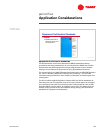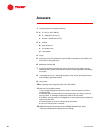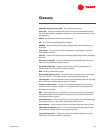
66 TRG-TRC013-EN
1 velocity pressure and static pressure
2aP
v
= 0.5 in. H
2
O [125 Pa]
b V = 2,832 fpm [14.4 m/s]
c Airflow = 4,248 cfm [2 m
3
/s]
3aairflow
b static pressure
c fan speed (rpm)
d input power
4 surge
5 forward curved (FC), backward inclined (BI) or backward curved (BC), and
airfoil (AF) or plug (plenum)
6 backward inclined (BI)
7 As the fan airflow increases, the nature of the fan’s input power curves
causes the fan’s power requirement to also increase, possibly overloading
the motor.
8 “riding the fan curve,” discharge dampers, inlet vanes, fan-speed control,
and variable-pitch blade control
9 inlet vanes
10 By adjusting (swiveling) the pitch of the fan blades.
11 Here are five possible causes:
1 Not enough straight duct at the fan inlet or outlet to ensure a uniform
velocity profile
2 A diffuser that connects the fan to the duct system, an elbow, a branch,
turning vanes, or a damper located too close to the fan outlet
3 An elbow, turning vanes, air straightener, or other obstruction located too
close to the fan inlet
4 Preswirling the air prior to it entering the fan wheel
5 Use of an inlet plenum or cabinet
12
AMCA Standard 210
(also known as
ASHRAE Standard 51
), titled
“Laboratory Methods of Testing Fans for Rating”
Answers


















